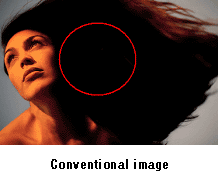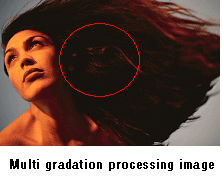PRESS RELEASE
May 26, 2004
Fujitsu General Limited
(NO.04-N01-07)
Advanced high picture quality technology of plasma displayDevelopment of full digital video processor "AVM-II" dedicated for new generation PDP ( * AVM : Advanced Video Movement ) |
||
Fujitsu General has developed a full digital video processor " AVM-II ( Advancced Video Movement II : hereafter called AVM-II ) " dedicated for new generation PDP corresponding to the world-wide trend of digital broadcasting and spread of digital storage device such as HD recorder through further advancement of the high picture quality reproduction technology of " AVM " system which is highly valued.
Plasma display realizes the display of high picture quality through two technologies of " Panel drive control technology " which controls the discharge of panel and " Video signal processing technology " which optimizes the video signal.
Since launching the world's first full color plasma display in 1993, we have been researching and developing the digital video signal processing technology which draws out PDP's performance to the maximum adapting to light emitting principle and drive system of PDP. Our high picture quality technology has been recognized and highly valued world-wide such as developing " AVM " system using the industry's first single chip LSI in 2001 and winning the " Emmy Award " in 2002, being the only plasma display which received this award.
The " AVM-II " is featured with new technologies such as
- " Digital noise reduction " suppressing the digital noise generated when editing and transmitting digital video images.
- " Low brightness multi gradation processing " enhancing gradation display in dark pictures up to 1019 displayable colors matching the characteristic of human eyes.
- " Natural color tuning " thoroughly pursuing the faithfulness of color reproduction through human eyes and recognizing and correcting the hue for each pixel.
- " IAP ( Image Adaptive Processing ) " automatically recognizing the contents of picture of each part in the screen and displaying the text clearly and persons or landscape smoothly.
High picture quality display beyond our conventional concept has been made possible by linking each processing according to various types of input signals or display pictures through integration of high quality video processing circuits of our own development including above new technology by " High Definition Digital Multi Conversion ( HDDMC ) " technology.
We will incorporate this technology into new " Plasmavision™ " models sequentially from October this year.
( " Plasmavision " is a registered trademark of Fujitsu General Limited. )


Photo : Left : AVM-II / Right : Logo design
Main features ( AVM*-II )
- " Digital noise reduction " suppressing generation of digital noise
- " Low brightness multi gradation processing " enhancing gradation display up to 1019 displayable colors
- " Natural color tuning " recognizing and correcting the hue for each pixel
- " IAP ( Image Adaptive Processing ) " distinguishing text and landscape, and optimizing each of them
1: "Digital noise reduction" suppressing generation of digital noise.
The digitalization of video images is rapidly progressing through launching of digital TV broadcasting in various countries of the world and digitalization of video recording device such as HD recorder. We are now enjoying high quality pictures owing to availability of high resolution video images by digitalization and ensuring optimal freshness of picture quality when transmitting and storing. As such digital video images have much data volume, the data is compressed when broadcasting or recording. In this case, peculiar noise ( compression distortion ) occurs, which is particularly noticeable in large-sized display.
In " AVM-II ", by detecting and eliminating the noise peculiar to digital images in high precision, a smooth picture can be displayed making use of large-size display which has high display ability. ( Patent Pending )

2 :"Low brightness multi gradation processing" enhancing gradation display up to 1019 displayable colors.
Because PDP is a digital display system, both dark video images and bright video images are displayed evenly. On the other hand, human eyes have higher detecting ability to dark objects than bright objects and can not be adjusted for dark video images. This has been a weakness of digital display.
In " AVM-II ", a smooth picture display has been made possible even
In " AVM-II ", a smooth picture display has been made possible even for dark objects by combining floating decimal point arithmetic matching the characteristic of human eyes with multi gradation processing, increasing display colors for dark objects to which detecting ability of human eyes becomes higher and making multi gradation display equivalent to maximum 1019 displayable colors for the darkest objects in designing. (Patent Pending)
3 :"Natural color tuning" recognizing and correcting the hue for each pixel
In displaying pictures, natural color reproduction is made possible only by balancing " natural color " reproducing original colors faithfully and " memory color " based on various human experiences. This balance between " natural color " and " memory color " needs to be maintained by focusing on mono tone color such as color of sky, lawn, human skin.
In order to realize this, we have developed and incorporated " natural color tuning " system recognizing and correcting the hue for each pixel.
In this system, natural and faithful pictures are realized by high displaying ability using floating decimal point arithmetic function of " AVM-II " making maximum use of wide color reproduction peculiar to PDP without relying on so-called " TV color " which exaggerates only " memory color " in CRT age. (Patent Pending)
4 :"IAP ( Image Adaptive Processing ) " distinguishing text and landscape and optimizing each of them
The integration of TV and PC is rapidly progressing through digitalization of broadcasting and improvement of video reproduction function of PC. In plasma display as a master screen for home use, it is required to display data information such as text and graphic display and video information such as still and moving pictures at the same time. On the other hand, as data information and video information look entirely different for human eyes, the video signal processing for optimum display is different between them. In the conventional system, different signal processing is made separately for data information and video information. Regardless of input source, by recognizing and processing data information and video information to the optimum for each pixel through IAP ( Image Adaptive Processing ) system, " AVM-II " can display data information clearly and video information faithfully even for the picture in which data information and video information are mixed. (Patent Pending)
Conventional System
Larger View
Contact details
Contents in each releace are at the time of release.
These contents are subject to change without prior notice.








 GLOBAL | English
GLOBAL | English





